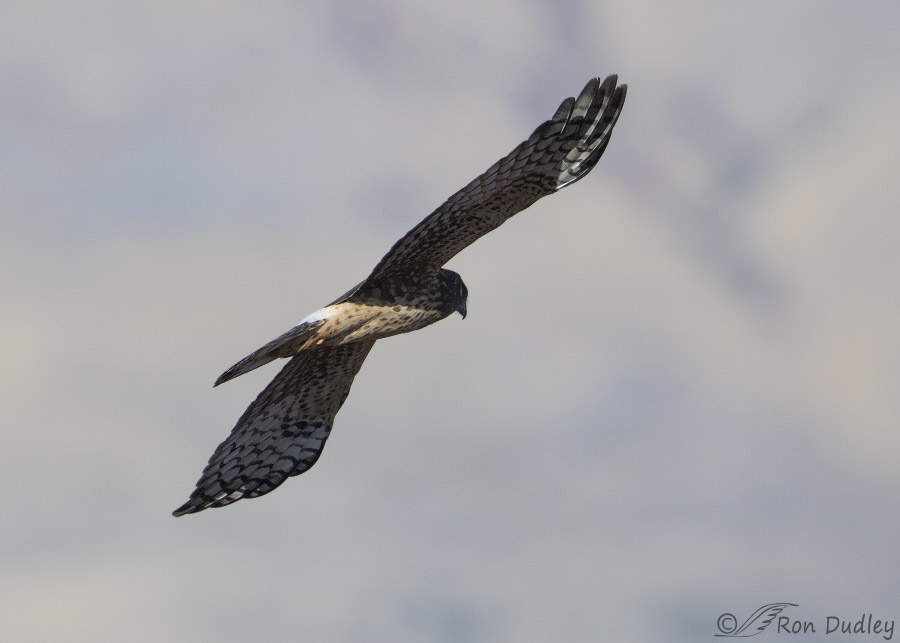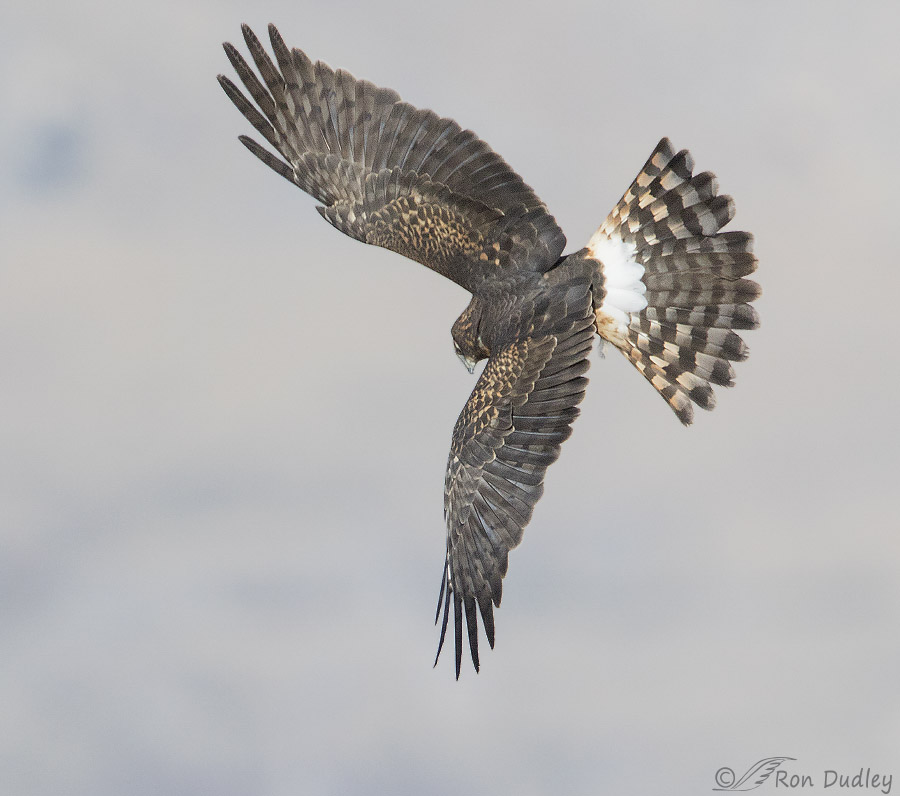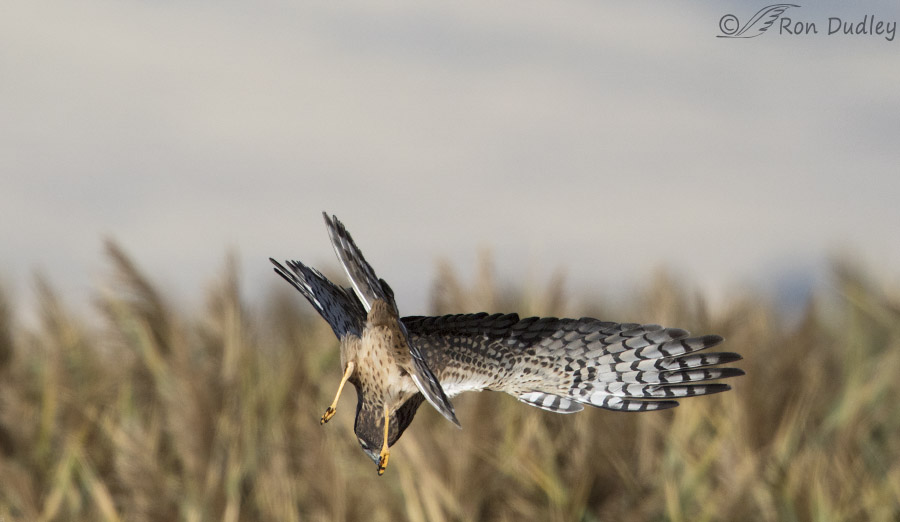You just never know what might happen when you have your lens trained on a hunting harrier (hint – few raptors can jink like a harrier can jink…).

1/6400, f/6.3, ISO 800, Canon 7D Mark II, Canon EF 500mm f/4L IS II USM + EF 1.4 III Extender, not baited, set up or called in
Two days ago at Bear River Migratory Bird Refuge I had some pretty good looks at this hunting Northern Harrier but by the time I got my pickup stopped, my lens raised and the bird in focus it had veered away from me at an angle that shaded most of its body. By then I figured all was lost but for some reason I kept my lens on the hawk and took a few shots anyway (I only include this one here to demonstrate how quickly and unexpectedly things can change with harriers).
Immediately after this photo was taken the harrier spotted (or heard) prey, most likely a vole, in the vegetation below and performed one of those patented hunting maneuvers that only harriers can do anywhere near as well.

1/8000, f/6.3, ISO 800, Canon 7D Mark II, Canon EF 500mm f/4L IS II USM + EF 1.4 III Extender, not baited, set up or called in
At lightning speed the bird jinked in the air and twisted its body completely around as it began its dive on prey. I instinctively fired a quick burst and caught the bird in a flight posture I’ve always lusted after from a harrier – with the bird perfectly vertical to me, its wings fully extended and its tail widely flared. I love this topside view of the hawk and I don’t remember ever seeing a better look at the entire dorsal plumage of a harrier in flight in a single photo so I was thrilled to get it despite the fact that we can’t see much of the eye.
Notice that in this flight situation only the alula on the right wing is extended.
When I first saw this shot I wished I’d been just a little closer to the bird for even better detail but if I had been I’d most likely have clipped a wing. I came close to clipping the right wing as it was (in these situations a little wiggle room is generally a good thing).

1/8000, f/6.3, ISO 800, Canon 7D Mark II, Canon EF 500mm f/4L IS II USM + EF 1.4 III Extender, not baited, set up or called in
In the next shot I caught the bird near the end of its short dive but it was barely in frame. Despite the obvious imperfections of the photo I still like to admire this dynamic diving posture with the asymmetrical wings, twisted body, skewed tail and both feet and head extended downward toward the prey they’re rapidly approaching in classic harrier style. I sure wouldn’t want to be a vole in this situation.
Sadly the harrier missed the vole but it wasn’t for lack of trying.
Ron
PS – Once again I’ve way overdone my shutter speed – no time to make adjustments.


As you usual !! Love your pictures but still confused I don’t get it !! My shutter speed is 2000 at the very most and you’ve got 8000 I don’t get …
Marina, Next time you’re in SLC we’ll have to do some test shots with your gear and mine on the same subject to see if we can figure it out. (so other readers know, Marina uses the same lens I do and she’s been confused by this apparent SS difference for a long time).
WOW-AND-A-HALF!!!!! Amazing shots, Ron! No matter what else happens today, I can pull these up in my mind’s eye to bring an immediate big silly grin to my face! (Count me among the dictionary-seekers today too.
Amazing shots, Ron! No matter what else happens today, I can pull these up in my mind’s eye to bring an immediate big silly grin to my face! (Count me among the dictionary-seekers today too.  )
)
There’s nothing wrong with consulting a dictionary now and again, Marty. I do it often. Thanks.
Wowsers.
It makes turning on a dime look sadly unabitious doesn’t it.
I am awed by that second shot and will quickly finish this comment so I can scroll back and marvel.
Thanks very much, EC.
Great photo Ron, you are right, it is a great topside view of the plumage.
Yesterday I was admiring a half dozen harriers in Southern Colorado and humbled by how rusty I have gotten in trying to photograph them. Watching this blurry acrobatic bird as I frantically tried to get my autofocus to lock on…no luck there, so I am happy to see your sharp images!
Thanks, Ed. Yes, maintaining focus during this maneuver is very difficult. That is usually my stumbling block in these situations.
Gorgeous! I love to watch these birds fly. They are the acrobats of the sky.
Thanks, Sharon.
I love to watch harriers. They are so athletic.
Me too.
These are amazing shots!!! I especially love the second one…it’s such an unusual angle…you almost never see a shot like that..a full dorsal view–which leaves a lot of information missing…all three are interesting…the last is an impressive capture!
“you almost never see a shot like that”
Agreed, Patty – shots like that don’t come every day, especially with the hawk perfectly vertical to the viewer. Thank you.
Oh WOW! Yeah, you know the drill…insert the string of ridiculously redundant superlatives here! That second shot is spectacularly beautiful. I love watching the fancy flights of Harriers! As Mia says, “Life is Good!”
Over the last 20-plus years, I’ve routinely wished for slow-motion replay vision as I’ve watched Mariah and Jack perform their fancy flying maneuvers. I maintain if you can watch them in their majesty, and it doesn’t regularly take your breath away, you really need to check your pulse. You could be dead! And after all these years, I swear I’ve never seen the moment they drop their legs into impending=death mode. It just happens far too rapidly for my only-human eyes to process. But I can usually hear the moment of smash, which is profound in itself!
Raptors are just over-the-top outrageously spectacular! (The writer in me cringes and screams–WORD space!! Word SPACE! REDUNDANT!) I’m so envious that you can capture these moments, these slices of time, stopping it so that my eyes can catch up
” stopping it so that my eyes can catch up ”
I like the way you said that, Laura – it’s perfect for what photographs of birds often do for us. Thank you.
How wonderful to catch these shots! I learned a new word today, too: jink. I have never seen it before, anywhere. I learn all sorts of things from you…
Susan, I’ve had other people (on FB) tell me they had to look up the word. I think it’s a good word for many birds.
WOW, WOW, WOW!!! I have witnessed this behavior many times in my life, but have never seen it so beautifully documented!
Harrier’s are surely the slow purposeful predatory acrobats of the air and you have done their maneuvers well! Congratulations!
Yup, they hunt low and slow and then when the spot prey they turn on the afterburners. Thanks, Dick.
I got to see a crow do similar aerobatics as my instructor and I shot between two of them while we were careening around the pattern in a Cessna, last weekend! We missed both… by few feet!
Wonderful series Ron!
Charlotte
Thanks, Charlotte.
Hi Ron,
Very, very nice images of one of my favorite birds. And, when we observe it during a field trip, the maneuver is always accompanied by a group-collective “WOW!”
Thanks!
Cheers,
Dick
I do that “wow” thing myself, Dick!
Ron, your second image has to be one of the best shots I’ve ever seen of a Northern Harrier. Great job!!!
Well, at least it’s one of MY best harrier shots, Ron. Thank you.
That 2nd photo is terrific. Colors!! Wingspread! Detail! Congratulations!
I’m glad you like it, LS. Thank you.
WOW! Even the 3rd shot shows what was going on……….. 2nd shot is magnificent – GREAT capture, Ron! Snow mostly gone here – glad I don’t live in Havre or on Rocky Boy!
Snow mostly gone here – glad I don’t live in Havre or on Rocky Boy! 
Thank you, Judy. I have friends who lived in Havre for decades and I’ve been thinking that right now they’re probably especially glad they moved to Flathead Lake after their recent retirement.
Bravo–well done Ron! We’ve been watching harriers perform this maneuver for many years–in wonder and awe–I can truly understand how difficult it was to get this shot! Such a beautiful bird
I can’t tell you how long I’ve been after a shot like this, Christine. Every time I’ve had a harrier in frame when this happens I lose focus when it jinks, or cut off body parts. Or both. It was fun to finally succeed. Thank you.
Hey Christine! And you’ve got a bunch of spectacularly beautiful images, too! Love you! Miss you!
Yes, she certainly does, Laura.
The tail spread is gorgeous in the 2nd photo. A difficult bird to photograph.
Thank you, Zaphir. Yes, harriers are usually tough subjects and I love that tail spread too.